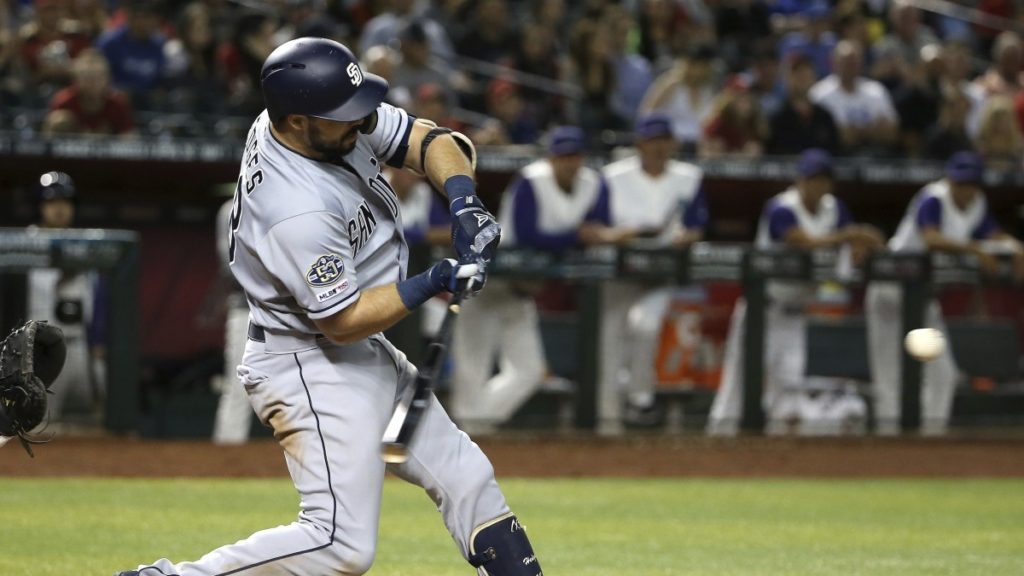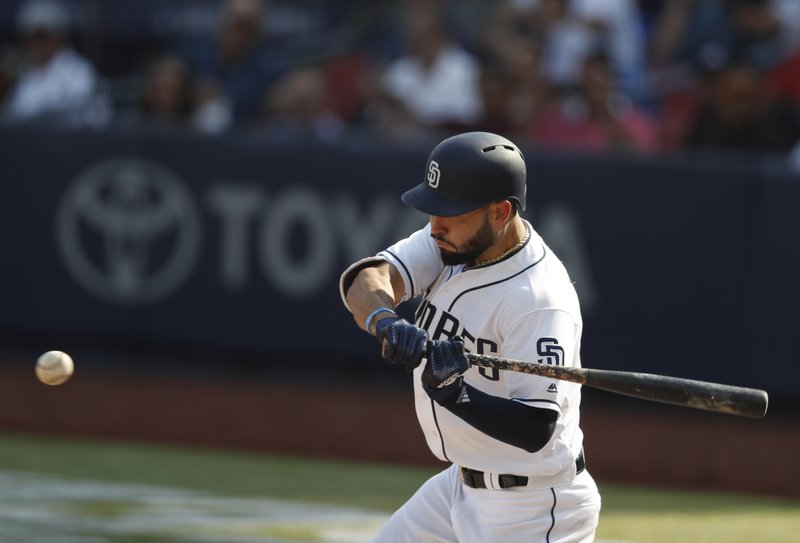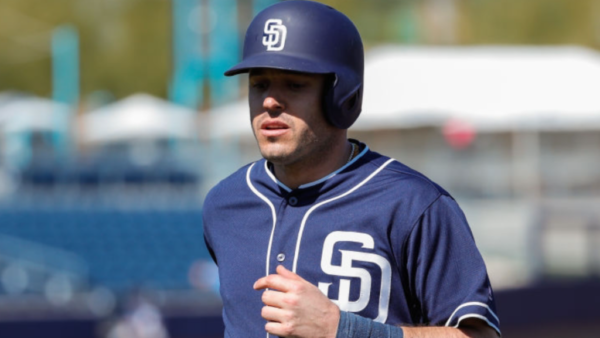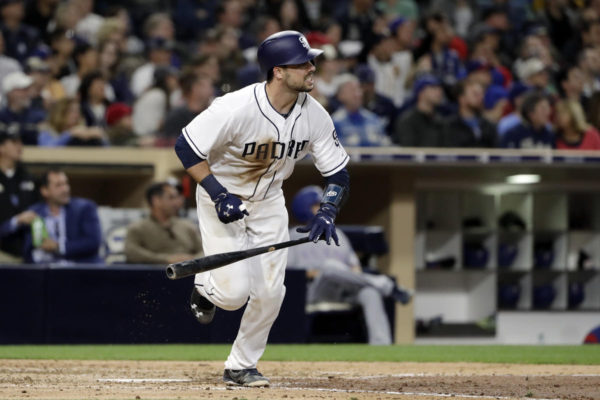Investigating The Slumping Padres Hitters

Credit: AP Photo

Even with the above-.500 start to the season, several Padres hitters are yet to get going at the plate.
It’s clear that the Padres are a better overall team than last year, just look at the records, run differential and heck, look at that guy playing third base. However, the Padres are still struggling to put crooked numbers on the board and give this suspect pitching staff the support it needs.
The Padres are 20th in team batting average and 21st in runs scored, not as horrible as they have been in the recent past, but with this lineup, it is borderline inexcusable. Let’s take a look at a few players who are slow out of the gates in April and what they can do to turn it around.
The most notable Padre slumping badly right now is their $144 million man. With the signing of Machado for over twice that contract, one would think the pressure would come off of Hosmer enough to let him be loose and easy at the plate, but so far, that has not been the case.
After last year’s disappointing first season in San Diego, with a .253 average, 95 wRC+ and career-high 21 percent strikeout rate, things have gotten worse. Through 18 games, he is hitting a dismal .194 with a 47 wRC+. Diamondbacks pitcher Zack Greinke has done more damage at the plate than Hosmer.
The narrative with Hosmer is that he refuses to hit the ball anywhere else, but on the ground and in this day and age of baseball, that just won’t do. However, it appears he has changed his approach in that matter. Last season he was second in the majors with a 60.4 percent groundball rate. This season, he is down to 49 percent and not even in the top 30 players for groundball rate, so there is something else happening here. Is he hitting the ball more softly, allowing fielders to get to it easier? Actually, the opposite is true. His hard contact rate is up from 34.5 percent last season to 45.1 percent, and in fact, his career hard contact rate is 33 percent, so Hosmer is hitting the ball harder than he ever has.
So he is hitting even fewer ground balls than last year and hitting the ball harder than ever, what is the deal? It could be as simple as bad luck. It’s far from perfect but one of the best indicators of a hitter’s luck is BABIP (batting average of balls in play), or how often do balls in play result in outs. Hosmer’s BABIP this season is at .240 which is 60 points worse than last year and over 70 points off of his career average, meaning Hosmer has been very unlucky so far this season.
| GB% | |
| 2018 | 60.4 |
| Career | 54.2 |
| 2019 | 49 |
| hard cont% | |
| 2018 | 34.5 |
| Career | 33 |
| 2019 | 45.1 |
| Swing% | |
| 2018 | 48.5 |
| Career | 47.8 |
| 2019 | 49.5 |
| O-Swing% | |
| 2018 | 33.1 |
| Career | 33.2 |
| 2019 | 32.3 |
Hosmer is even swinging at fewer pitches outside of the zone this season. He is swinging slightly more overall but that can be explained by his four percent rise in swinging at pitches inside the zone (not shown). One could argue he is being less picky about swinging at strikes, but that doesn’t explain why his contact has been much harder this year. For now, this really may be just sheer dumb luck. Remember, Hosmer is a nine-year veteran and is still not even 30 years old.
Solution: Stay the course and be patient, hits will fall.
Kinsler is another established veteran who has stumbled out of the gate. Age decline may be more of a factor for Kinsler than Hosmer, as Kinsler is almost ten years older than Hosmer, but it may not be that simple. Kinsler is hitting .148 with one home run and a 35 wRC+, even worse numbers than Hosmer. Kinsler is a career .270 hitter with a lifetime 108 wRC+.

His calling card has been making contact, and last season, he was among the ten hardest batters to strike out. This year, his strikeout rate is at 18 percent, while his career rate is 12.4 percent. Perhaps the most telling stat for Kinsler is his swing-and-miss rate. Last season, which was still not a good season by his standards, he swung and missed 5.1 percent of the time, which is right around his career mark of 5.3 percent. This season, he is swinging and missing at a 7.8 percent clip, which would be a career high.
Couple that with the fact that he is pulling the ball more this year than ever, a few things could be at play. One, he could be pressing and trying to hit home runs, knowing Luis Urias is breathing down his neck, and his everyday playing career may be towards the end. Another is that he has gone away from his approach at the plate to all fields and is now just trying to pull the ball, flying his shoulders open to fast. This is the first time he has played in the National League in unfamiliar ballparks and cities; he might be having a hard time adjusting to all this change and sticking to what he does best.
| Swing Strk% | |
| 2018 | 5.1 |
| Career | 5.3 |
| 2019 | 7.8 |
| Pull% | |
| 2018 | 43.7 |
| Career | 45.5 |
| 2019 | 55.8 |
| O-Swing% | |
| 2018 | 27.1 |
| Career | 24.5 |
| 2019 | 30.1 |
Kinsler also seems to be swinging at more pitches outside the zone. This may be another symptom of him pressing, trying to get the big hit and break out of this funk and stay the arrival of Urias and prolong his career, as any proud veteran would do. Plus, he is having a string of bad luck as Homser is, with a .167 BABIP when his career rate is .282.

Solution: Get back to basics, stop pulling the ball so much and trust the approach that has lasted for 14 seasons.
We all know Hedges is never going to be Ivan Rodriguez or Mike Piazza at the plate. However, there does come the point where his poor offensive performance will outweigh his stellar defense. As it stands today, that is the case with his 2019 output. One could argue that this is where that point is, as his WAR is 0.0 despite being one of the best defensive catchers in the game. Hedges is currently batting .200 with two home runs, a .648 OPS and a 66 wRC+. He has always been a high strikeout hitter, with his career mark at 27.9 percent (league average at around 20 percent). Unfortunately, unlike Hosmer or Kinsler, Hedges does not have a reliable track record to indicate that he ever will turn into a consistent hitter.
This season, he is pulling the ball at an alarming rate. According to FanGraphs, any player who has at least a 55 percent pull rate is considered an “extreme pull” hitter. Hedges is at 60 percent this season, which is even higher than his career of 43.5.
| Pull% | |
| 2018 | 48.1 |
| Career | 43.5 |
| 2019 | 60.7 |
| Hard cont% | |
| 2018 | 36.9 |
| Career | 32.5 |
| 2019 | 42.9 |
| O-Swing% | |
| 2018 | 36.3 |
| Career | 37.2 |
| 2019 | 31.2 |
He is more disciplined at the plate than he has ever been but does not have the improved strikeout numbers to show for it. He is even hitting the ball harder than he ever has, the problem is they are all going to the left side of the infield, and the defense has that figured out.
Solution: Hit the ball more the other way, strive for contact instead of going for the home run.
Urias is a bit harder to evaluate since his sample size is smaller than the rest, including his overall career numbers. He only has 24 plate appearances through Wednesday while most of his teammates are north of 60. Still, the early returns on Urias’ call-up have been abysmal as he has just two hits with a 29.2 percent strikeout rate and a 23 wRC+. Urias is praised for his mature approach and patience at the plate. He still displays that elite discipline as he has a 17.7 percent swinging outside of the strike zone rate when the average is 30 percent.
| O-Swing% | |
| 2018 | 29.4 |
| Career | 25.5 |
| 2019 | 17.7 |
| Hard cont% | |
| 2018 | 30.8 |
| Career | 32.7 |
| 2019 | 38.5 |
Urias is hitting the ball harder than he did last season, but given his dreadful .154 BABIP, they are almost all finding gloves. With his discipline still better than average (a 12.5 percent walk rate is elite) and his batted balls flying harder and faster, it’s only a matter of time for Urias. This looks like a classic case of just needing more at-bats.
Solution: Play every day
It came as a surprise to most that Mejia made the Opening Day roster even though Hedges is the assumed starter. Mejia is not playing every day and is in a similar boat to Urias. Mejia can be immensely valuable to this team as a switch-hitting catcher with lots of upside at the plate. As of now, he is hitting .143 with a one wRC+. It looks like Mejia is having an issue resembling his catching counterpart as he is pulling the ball at an even greater rate than Hedges, at 61.9 percent. As a switch hitter, things are a bit more complex. As a left-handed batter facing right-handers, even in just eight plate appearances, his pull rate is 71.4 percent while making far less hard contact as a lefty.
| O-Swing% | |
| 2018 | 53.6 |
| Career | 50.2 |
| 2019 | 41.2 |
| Pull% | |
| 2018 | 56.8 |
| Career | 58.8 |
| 2019 | 61.9 |
Again, as with Urias, this is a case of far too little plate appearances to make any sort of judgment. Is Mejia better off in Triple-A, playing every day? That’s for A.J. Preller to decide.
Solution: More plate appearances
The Padres are not even 20 games in so it is very early to make any judgments, good or bad. Baseball is a long season, and things tend to even out.
Native of Escondido, CA. Lived in San Diego area for 20 years. Padres fan since childhood (mid-90s). I have been writing since 2014. I currently live near Seattle, WA and am married to a Seattle sports girl. I wore #19 on my high school baseball team for Tony Gwynn. I am a stats and sports history nerd. I attended BYU on the Idaho campus. I also love Star Wars.
Padre batters often take one or even two strikes early and then swing at pitches out of the zone . Is this because of the offensive philosophy of our coaches to run up pitch counts or are our hitters guessing wrong on what the pitcher is going to throw? Whatever the reason, the results are far too often negative. We need to be smarter, more aggressive, trying to hit for better averages, and not always going for a homer at all times during the at bat and protect better with two strikes. We have too many rally killers in our lineup just for these reasons. Number 19 is the perfect example that these Padres should be trying to emulate. The job is not over once the game ends. There is video study and practice for endless hours if you want to be great. Tony was just that.
Um, really? A guy strikes out too much and the solution is “hit for contact”?
Doctor, it hurts when I walk this way. So don’t walk that way.
More useful analysis might be:
1) send Mejia down to AAA so he can play every day, and realize that with a young staff Hedges needs to be the main catcher.
2) let Urias play everyday, and use Kinsler as a reserve. Could be Kinsler is through being an acceptable bat. If neither are hitting, go with the player with upside, that’s Urias.
3) start platooning Hosmer. Perhaps this will make it easier to implement a new swing, by shielding him against the toughest pitchers. The OFs aren’t getting the ABs they deserve, by making Myers the 1B against LHP, you get guys like Reyes and Renfroe more ABs. Due to his contract this is going to be a bitter pill to swallow, but the team needs to have a plan to replace Hosmer.
Outstanding article. Great research and insight
Outstanding article and analysis! Thanks